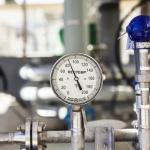The Methane Beneath Our Feet

Insouciant New Yorkers—here is another pending disaster to shrug off with characteristic brio! There is a huge, ongoing gas leak beneath your very feet. A team of natural gas experts recently commissioned to survey the New York system has found vastly elevated levels of methane in locations all over Manhattan, a clear indication that Con Ed’s 4,320-mile network of pipes, dating back to the 1800s, is corroded, full of holes, and spewing methane into the atmosphere. The main danger here is to planetary, not personal, safety: though it has received relatively little attention, methane, the primary component of natural gas, is second only to carbon dioxide on the list of greenhouse gases that are inducing climate change.
This unhappy news actually comes as little surprise to those who have been following the issue of gas leakages in recent months. Similar revelations actually began to emerge some years ago, when a Boston University professor named Nathan Phillips began trying to figure out how much gas was leaking from pipes in Boston. He fell in with a former local gas company contractor named Bob Ackley, who had been hired by gas companies throughout New England to find leaks, which he discovered were pervasive. As the years passed, he realized his employers considered gas lost from a myriad number of small leaks simply a cost of doing business, and declined to take remedial action unless there was immediate risk of explosion. Dismayed, Ackley struck out on his own as a whistleblower, finding an ally in Phillips. (The intertwined story of Phillips and Ackley is well-told by young journalist Phil McKenna in a recent e-book, Uprising, which also provides useful background.)
Because of the grave threat methane poses to the climate, the dangers of natural gas leakages go well beyond the immediate risk of exploding manhole covers (though recent measurements in Washington, DC indicate that there is enough leaking gas to cause any cautious pedestrian a certain amount of worry). And given the vastness of the problem, the leaks challenge some of the basic assumptions of current US energy policy, which has aggressively endorsed natural gas as a “clean” and climate-friendly alternative to oil and coal.
Over the last four years, American leaders have boasted a great deal about the fact that our country has lowered its carbon emissions, mostly by switching some power stations off coal as the fracking boom has lowered the cost and increased the supply of natural gas. Burned in a power plant, gas gives off half the carbon that coal does—hence it’s been seen by some as a “bridge fuel” to alternative energy. Even some environmentalists have argued that we should ignore the dangers to water supplies posed by fracking in order to reap the carbon benefit.
The trouble, however, is that the methane in unburned natural gas is twenty to one hundred times more potent than carbon dioxide as a greenhouse gas. That makes the math fairly simple: if more than two to three percent of the gas escapes into the atmosphere during transit between its point of extraction in the ground and its final destination—oven, furnace, or powerplant—then natural gas is actually doing more damage to the climate than coal. A 2011 paper by a pair of Cornell scientists estimated that the rate of leakage in the fracking process might be as high as four or five percent, numbers that the natural gas industry scoffed at. But earlier this year a National Oceanic and Atmospheric Administration (NOAA) study of a gas field in Colorado and Utah found leak rates as high as 9 percent. Those numbers seem almost certainly too high—Nature called them a “small snapshot”—but they also only measure leaking during fracking and pumping. Once natural gas is delivered to a network like New York’s, pipes with holes in them obviously add to the problem.
More methane is accumulating in the atmosphere; the uptick began in 2007. While this coincides with the advent of fracking, NOAA scientists think that, for the moment, more of the rise is coming from increased emissions from tropical wetlands, and perhaps melting Arctic tundra. Still, they say that “in the long term,” increased natural gas drilling may also put upward pressure on global methane emissions (especially if, as seems likely, the fracking boom spreads around the world.)
The most corporate-minded of the big environmental groups, the Environmental Defense Fund, announced this winter that it would join with Shell, Chevron, and others to certify fracking wells, part of an effort to reduce leakage. This move was quickly denounced by more mainstream environmental organizations like the Sierra Club, as well as local anti-fracking groups (one of which paid for the Manhattan leak study). They pointed out the other huge problem with increased reliance on cheap natural gas: it undercuts the transition to zero-carbon energy sources like solar and wind power, locking us into long-term reliance on fossil fuels. (Indeed the International Energy Agency recently modeled a world that converted heavily to “clean” gas and found that its temperature still rose 6 degrees Fahrenheit, a disastrous outcome.)
The EDF plans to announce the results of a study of its own in late April, presumably adding yet another set of figures to the estimates of gas leakage. For the moment, however, the new Manhattan findings add to the growing impression that the carbon reduction achieved during the Obama administration-supported natural gas boom may be a Pyrrhic victory—or perhaps a better metaphor is a fad diet that cuts weight quickly, but only for a short time, and at the expense of the long-term changes in energy consumption we need to give ourselves a real chance at a healthy future.
April 1, 2013, 1:03 p.m.
